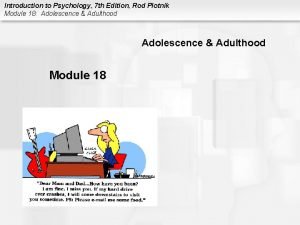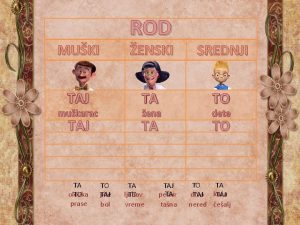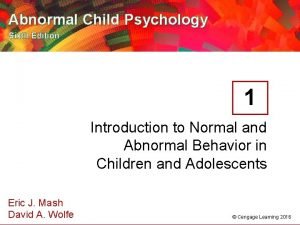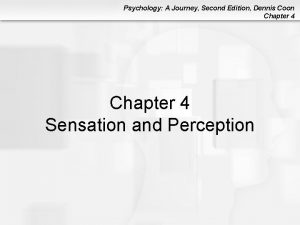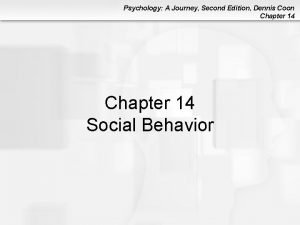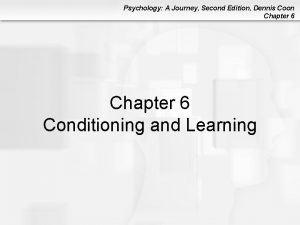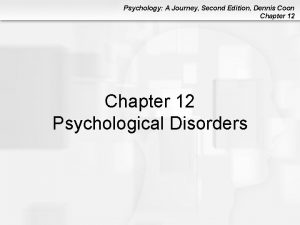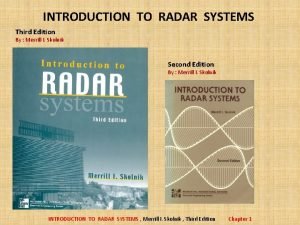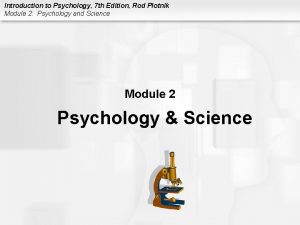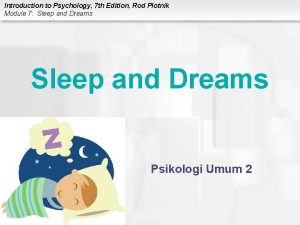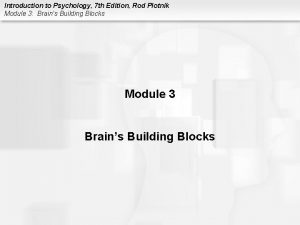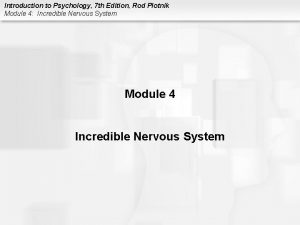Introduction to Psychology 7 th Edition Rod Plotnik
























- Slides: 24

Introduction to Psychology, 7 th Edition, Rod Plotnik Module 7: Sleep and Dreams Module 7 Sleep and Dreams

Introduction to Psychology, 7 th Edition, Rod Plotnik Module 7: Sleep and Dreams 1. Sleep Quiz 2. 3. 4. 5. 6. 7. 8. 9.

Introduction to Psychology, 7 th Edition, Rod Plotnik Module 7: Sleep and Dreams

Introduction to Psychology, 7 th Edition, Rod Plotnik Module 7: Sleep and Dreams CONTINUUM OF CONCIOUSNESS • Different states Consciousness • refers to different levels of awareness of one’s thoughts and feelings – Continuum of consciousness • refers to a wide range of experiences, from being acutely aware and alert to being totally unaware and unresponsive

Introduction to Psychology, 7 th Edition, Rod Plotnik Module 7: Sleep and Dreams CONTINUUM OF CONCIOUSNESS (CONT. ) • Different states Controlled processes • activities that require full awareness, alertness and concentration to reach some goal Automatic processes • activities that require little awareness, take minimal attention, and do not interfere with other ongoing activities Daydreaming • activity that requires low level of awareness, often occurs during automatic processes, and involves fantasizing or dreaming while awake

Introduction to Psychology, 7 th Edition, Rod Plotnik Module 7: Sleep and Dreams CONTINUUM OF CONCIOUSNESS (CONT. ) Altered states – result from using any number of procedures, such as meditation, psychoactive drugs, hypnosis, or sleep deprivation, to produce an awareness that differs from normal consciousness – sleep (5 stages) and dreams

Introduction to Psychology, 7 th Edition, Rod Plotnik Module 7: Sleep and Dreams p 150 SUPRACHIASMATIC NUCLEUS

Introduction to Psychology, 7 th Edition, Rod Plotnik Module 7: Sleep and Dreams CONTINUUM OF CONCIOUSNESS (CONT. ) • Different states – Unconscious and implicit memory – Unconscious • can result from disease, trauma, a blow to the head, general medical anesthesia • results in total lack of sensory awareness and complete loss of responsiveness to one’s environment

Introduction to Psychology, 7 th Edition, Rod Plotnik Module 7: Sleep and Dreams RHYTHMS OF SLEEPING & WAKING • Biological clocks – biological clocks are internal timing devices that are genetically set to regulate various physiological responses for different periods of time • Circadian rhythm – refers to a biological clock that is genetically programmed to regulate physiological responses within a time period of 24 hours

Introduction to Psychology, 7 th Edition, Rod Plotnik Module 7: Sleep and Dreams RHYTHMS OF SLEEPING & WAKING (CONT. ) • Location of biological clocks – Suprachiasmatic nucleus • part of hypothalamus • lies in the lower middle of the brain • regulates sleep-wake cycle • Highly responsive to change in light

Introduction to Psychology, 7 th Edition, Rod Plotnik Module 7: Sleep and Dreams RHYTHMS OF SLEEPING & WAKING (CONT. ) • Location of biological clocks – interval timing clock – can be started and stopped like a stopwatch – gauges the passage of seconds, minutes, or hours – helps creatures time their movements, such as knowing when to start or stop doing some activity – located in the basal ganglia

Introduction to Psychology, 7 th Edition, Rod Plotnik Module 7: Sleep and Dreams Sleep Studies

Introduction to Psychology, 7 th Edition, Rod Plotnik Module 7: Sleep and Dreams RHYTHMS OF SLEEPING & WAKING (CONT. ) • Circadian problems and treatments – accidents – jet lag – resetting clock – melatonin

Introduction to Psychology, 7 th Edition, Rod Plotnik Module 7: Sleep and Dreams Sleep Disorders

Introduction to Psychology, 7 th Edition, Rod Plotnik Module 7: Sleep and Dreams WORLD OF SLEEP (CONT. ) • Non-REM sleep-4 stages Stage 1 sleep • transition from wakefulness to sleep that lasts 1 -7 minutes • gradually lose responsiveness to stimuli and experience drifting thoughts and images • presence of theta waves

Introduction to Psychology, 7 th Edition, Rod Plotnik Module 7: Sleep and Dreams WORLD OF SLEEP (CONT. ) • Non-REM sleep Stage 2 sleep • beginning of what we know as sleep • high-frequency bursts of brain activity called sleep spindles • muscle tension, body temperature and heart rate gradually decrease • more difficult to be awakened

Introduction to Psychology, 7 th Edition, Rod Plotnik Module 7: Sleep and Dreams WORLD OF SLEEP (CONT. ) • Non-REM sleep Stages 3 and 4 • also called slow wave or delta sleep • waves of very high amplitude and very low frequency (delta waves) • stage 4 is often considered the deepest stage of sleep • most difficult to be awakened from • heart rate, respiration, temperature, and blood flow to the brain are reduced • marked secretion of growth hormone (GH), controls levels of metabolism, physical growth, and brain development

Introduction to Psychology, 7 th Edition, Rod Plotnik Module 7: Sleep and Dreams WORLD OF SLEEP (CONT. ) • REM sleep (rapid eye movement) – makes up the remaining 20% of your sleep time – pass into REM sleep about five or six times throughout the night with about 30 to 90 minutes between periods – REM sleep remains for about 15 to 45 minutes then passes into non-REM sleep

Introduction to Psychology, 7 th Edition, Rod Plotnik Module 7: Sleep and Dreams p 154 SLEEP CHART

Introduction to Psychology, 7 th Edition, Rod Plotnik Module 7: Sleep and Dreams WORLD OF DREAMS • Theories of dream interpretation – Freud’s theory of dream interpretation - protection • we have a “censor” that protects us from realizing threatening and unconscious desires or wishes, especially those involving sex or aggression • “censor” protects us from threatening thoughts by transforming our secret, guilt-ridden and anxiety-provoking desires into harmless symbols that appear in our dreams and do not disturb our sleep or conscious thoughts

Introduction to Psychology, 7 th Edition, Rod Plotnik Module 7: Sleep and Dreams WORLD OF DREAMS (CONT. ) • Theories of dream interpretation Extensions of Waking Life Theory • dreams reflect the same thoughts, fears, concerns, problems, and emotions that we have when awake Activation-Synthesis Theory • dreaming occurs because brain areas that provide reasoned cognitive control during the waking state are shut down • sleeping brain is stimulated by different chemical and neural influences that result in hallucinations, delusions, high emotions, and bizarre thought patterns that we call dreams

Introduction to Psychology, 7 th Edition, Rod Plotnik Module 7: Sleep and Dreams WORLD OF DREAMS (CONT. ) • Typical dreams – What do people dream about? • several characters • involve motion • take place indoors more often than out • visual sensation, but rarely sensations of taste, smell, or pain • seem bizarre, may include flying or falling without injury • may be recurrent (dreams of being threatened, pursued, or trying to hide)

Introduction to Psychology, 7 th Edition, Rod Plotnik Module 7: Sleep and Dreams WORLD OF DREAMS (CONT. ) • Typical dreams – involve emotions of anxiety or fear rather than joy or happiness (limbic system is active) – rarely involve sexual encounters and are almost never about sexual intercourse – rarely can we control or dream about something we intend to dream about – dreams usually have visual imagery and are in color in sighted people – blind people from birth, dream in tactile, olfactory, or gustatory (taste), not visual

Introduction to Psychology, 7 th Edition, Rod Plotnik Module 7: Sleep and Dreams
 Introduction to psychology rod plotnik
Introduction to psychology rod plotnik Srednji rod primeri
Srednji rod primeri Plotnik
Plotnik Using mis 10th edition
Using mis 10th edition Mis
Mis Levels of analysis psychology
Levels of analysis psychology David myers psychology 9th edition
David myers psychology 9th edition Lazarus cognitive appraisal theory
Lazarus cognitive appraisal theory Psychology eighth edition david g myers
Psychology eighth edition david g myers Abnormal child psychology 6th edition
Abnormal child psychology 6th edition David g myers psychology 8th edition
David g myers psychology 8th edition Abnormal psychology comer 9th edition
Abnormal psychology comer 9th edition Psychology ninth edition david g myers
Psychology ninth edition david g myers Social psychology ninth edition
Social psychology ninth edition Psychology
Psychology Psychology a journey 4th edition chapter 1
Psychology a journey 4th edition chapter 1 Psychology a journey 4th edition chapter 1
Psychology a journey 4th edition chapter 1 Psychology a journey 4th edition chapter 1
Psychology a journey 4th edition chapter 1 Psychology tenth edition in modules
Psychology tenth edition in modules Psychology ninth edition in modules
Psychology ninth edition in modules Marketing an introduction 6th canadian edition
Marketing an introduction 6th canadian edition Introduction to teaching becoming a professional
Introduction to teaching becoming a professional Introduction to sociology 9th edition
Introduction to sociology 9th edition Skolnik introduction to radar systems
Skolnik introduction to radar systems Introduction to information systems 6th edition
Introduction to information systems 6th edition
